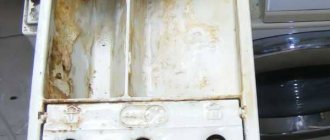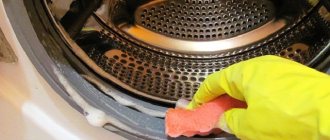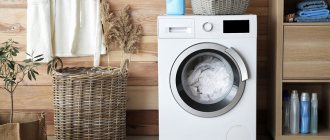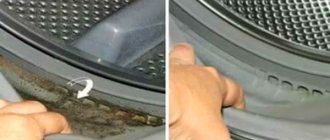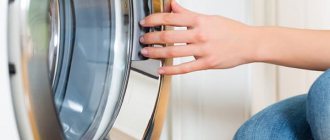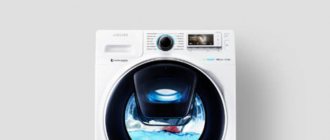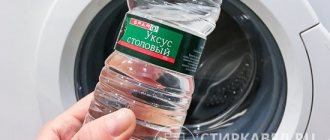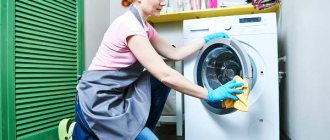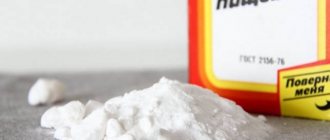Cleaning the body, door and sealing rubber
The rubber seal or cuff of the washing machine is a mandatory element of cleaning during the maintenance process. Rubber should be cleaned carefully, but efficiently, so that there are no leakage problems. Dirt and mold accumulate in this place - which is why it is important to clean regularly. Sediments in this area contribute to the appearance of unpleasant odors.
Any cleaning agent will help in the process, including regular baking soda. In some cases, if mold and a strong smell have already appeared, then it is worth using household chemicals:
- "Domestos".
- "Comet".
- “Whiteness” - it cannot be used often, as this leads to the destruction of the rubber seal. As a result, it will need to be changed.
The order for different means does not differ; it looks like this:
- Apply the product to the sponge.
- Carefully unscrew the cuff of the washing machine towards you.
- Wipe the metal elements of the housing.
- Clean the rubber itself. And not only in the lower part, where dirt accumulates the most, but throughout the entire diameter.
Important! Do not rub very hard so as not to damage the elastic band and other elements of the machine.
You also need to clean the car door. This can be done using a vinegar solution; you will need a 50% concentration of vinegar essence. It’s not difficult to prepare – just take equal parts of essence and water and mix well. All that remains is to wipe the glass and wipe it dry with a dry cloth. Gloves should be used when working with the solution.
The external elements of the washing machine should be wiped with a damp sponge; if necessary, you can use the existing cleaning agent.
Top brands
The popularity of models often depends on the brand name. However, not all new products, despite the abundance of advertising, may appeal to customers. It is much easier to give preference to the products of enterprises that have been tested by time and market competition.
Before deciding which product is better to buy, which brand, it doesn’t hurt to get acquainted with the most famous brands.
According to the Yanashl website, the leaders are:
- BAGI
Israeli brand. Year of birth: 1988. The company has developed a whole line of products for caring for household appliances and keeping the house clean. The brand is known in Europe, the USA, and Russia. Many popular models belong to this brand.
- Electrolux
Swedish brand. The company was founded in 1910, the main production is household appliances. But, as you know, devices need hygiene. Therefore, Electrolux produces related products to easily clean mechanical assistants at home.
- Nagara
Japanese enterprise Nagara Kagaku Kougyou Co. Ltd. known since 1960, its products include toiletries, detergent compositions, including for cleaning the washing machine. The brand is popular all over the world because the quality of the products is impeccable. “Sincerity and trust” is the company’s motto.
- Tiret
The international brand belongs to Reckitt Benckiser. The company was formed as a result of the merger of the German company Benckiser, which has existed since 1923 and produces chemicals, and the British Reckitt, which has been famous for home care products since 1940. Customer reviews of the brand's products are positive.
- Miele
German brand of premium household appliances, existing since 1899. Founders: Karl Miele and Reinhard Zinkann. The company's products are known in 37 world powers, and related products are also in demand. To the question: “Which company is better to buy cleaning products,” many housewives answer: Miele.
- Beckmann
Another German trademark. On the market since 1934. Repeatedly awarded with the “Best Brand” award. The company was awarded the Hessian Export Prize in 2013 in the category “Innovative Export Strategy”. In 2022, the products have a new stylish design.
- Filtero
Russian trademark. One of the leaders in the domestic market in the sale of vacuum cleaners, accessories and cleaning products for the home and household appliances. According to the manufacturer, the products meet European quality standards.
- Top House
The brand was created domestically. When advertising products, it is indicated that production is located in Western Europe and complies with European standards. You can buy Top House brand products only in the countries of the former Soviet Union and Russia.
Cleaning the powder tray
Before cleaning this component of the washing machine, it must be removed. If you don’t remember how to do this, it’s better to look in the instructions for the device so as not to break anything in the process. If you can’t remove the tray (this happens), you can still clean it, but you will need to pre-soak it. There are many places in the tray that are difficult to reach. To soak, you need to make a solution of any detergent and spray the tray with a spray bottle, leave for 2-3 hours. After this, cleaning will be much easier.
If you managed to remove the tray, then everything is even easier. If residues of powder or other product are found inside, it should be removed. This element needs cleaning, as over time a coating of rust, powder and other products forms on it. The following will help in removing all this plaque:
- Soda-vinegar mixture - proportions 1:2.
- Hot water + baking soda + vinegar - you need 3 parts water, 1 part baking soda and 2 parts vinegar.
Having prepared the product, it should be applied to all elements of the tray and left for 2-3 hours. Only then start cleaning with a sponge (large elements) and a toothbrush (hard-to-reach places). All that remains is to rinse the tray under running water and let it dry or wipe it dry.
Advice! If you have a dishwasher, you can wash the tray in it. It will not help get rid of plaque completely, but after such preliminary cleaning it will be easier to remove dirt.
How to find out about rust without disassembling the equipment?
It will not be difficult to understand that the internal elements of an automatic machine are rusty. After finishing your next wash, inspect the laundry. Particles of plaque along with soapy water fall into the drum, and then onto the clothes. As a result, brown rust spots may appear on clean items.
In addition, you can find out that the washer is rusting inside by the following signs:
- rusty streaks in the detergent tray, tray;
- brown-orange stripes and spots on the hatch door cuff;
- red smudges on the surface of the drum.
An automatic machine that is collapsing from the inside smells unpleasant. Debris and dirt accumulate in it, which prevents water and detergents from being completely removed from the system. The aggressive environment formed inside the unit provokes oxidation of metal parts and components. On the drum, if it is not made entirely of stainless steel, but only has a protective coating, traces of corrosion may appear.
Cleaning the filter
The drain pump filter is an important part of the machine; if you do not pay proper attention to it, sooner or later a blockage will form and the washing machine will not drain water at all. There is no need to invent any complicated cleaning methods, everything is extremely simple. To do this, you will need a small container, a towel or rag, or any flat object that will help open the hatch.
The order is:
- Open the hatch to gain access to the filter drain hose.
- Before unscrewing the filter, lay down a rag (towel) and place a container - a small volume of water will flow out of the hole. Maximum - 0.5 l, very rarely more.
- After removing the lid (unscrewing it completely), you need to remove accumulated debris, dirt, sometimes there are coins, wool and other foreign objects.
- Wipe the hole, rinse the lid, reassemble in reverse order.
The washing machine also has a water inlet filter, which should also be cleaned. Over time, clogging with rust and sand occurs. If these deposits are critical, then an error appears on the machine screen, which can be interpreted as “water collection is impossible.”
Important! The hose located directly on the water supply should be cleaned no more than 2-3 times a year.
The process looks like this:
- Close the water supply tap to the device.
- Open access to the back cover; often the device needs to be unfolded.
- The water supply hose is located at the top right.
- You should unscrew the nut that secures it counterclockwise.
- You can see a mesh filter inside. It should be removed and washed with a toothbrush under running water.
- All that remains is to put the filter in place and screw on the hose.
Prevention
You can prevent the occurrence of persistent deposits that can cause the washing machine to break down by using simple preventive methods:
- Knowing that crystallization of alkaline earth metal salts in hard water occurs at temperatures above 75 degrees, preference should be given to programs in which items are washed with water heated to lower temperatures. This will reduce the threat of scale on the heating element.
- You can reduce the hardness of tap water (and thereby ensure the cleanliness of all parts of the washing machine) using a magnetic filter installed in the pipe connected to the washing machine.
- In order for the automatic machine to last as long as possible, preventative cleaning of its main parts should be done twice a year. In regions with hard water, such prevention should be performed every eight weeks.
- Since cheap powders contain many harmful compounds that negatively affect the condition of the heating element, it is better to give preference to more expensive but high-quality detergents containing special softening components. At the same time, the amount of detergents used (including powder, conditioner and bleach) must strictly comply with the manufacturer’s instructions, since their excess not only does not improve the quality of washing, but also accumulates inside the unit, shortening its service life.
- Before putting things into the drum, it is necessary to empty the pockets of debris and small objects: this will prevent the drain filter from clogging.
- When caring for your washing machine, do not neglect simple rules that help maintain its working condition: do not leave wet items in the drum for a long time; after each wash, the unit must be wiped from the inside with a soft, dry cloth; The machine door should be kept ajar to avoid mold formation.
How long an automatic washing machine will last largely depends on the timeliness and quality of its care. The products used to perform preventive cleaning at home are accessible, easy to use and completely safe for all parts of the unit.
How to remove scale with citric acid
The biggest enemy of the internal parts of the machine is scale. You can fight it with the help of special chemicals, or you can use citric acid.
The main object is the heating element or heating element. For him, scale has a detrimental effect. Citric acid will also effectively remove scale from all metal elements of the washing machine. The procedure is simple, you don’t even have to use a rag or sponge, it consists of the following steps:
- Free the device from all things.
- Pre-rinse the cuff and door glass.
- Pour citric acid into the powder compartment. For cars with a volume of 5 kg - 100 g, 6 kg - 120 g.
- Turn on the washing machine at +90⁰ and the longest program.
- Once the cycle is completed, the cleaning is also completed.
The main protection of heating elements is timely descaling.
Important! There are special products for removing scale, for example the domestic “Antinakipin” and “Doctor TEN”. To soften water and prevent scale formation, use Calgon or its cheaper analog Refine.
Citric acid not only removes scale, but also helps get rid of unpleasant odors and mold.
You can also descale your washing machine with vinegar. This method is extremely simple, very similar to the option with citric acid. The work will require 9% vinegar, which must be poured into the powder compartment in an amount of 100 ml. The machine should be started at the longest and highest temperature setting. When the water heats up, stop the cycle for 1.5 hours, then allow the process to complete.
Reasons leading to drum contamination
How nice it is to get clean, fragrant laundry out of the washing machine! However, not all contaminants are removed from clothes during washing - some of them settle outside and inside the drum.
Sand and dust
Sand and street dirt penetrate into the washing machine tank along with soiled items - children's clothes from the sandbox, sneakers or sneakers, various uniforms. Grains of sand and particles of rust from the water supply can also get into the device if a hard filter is not installed on the water supply hose.
During washing, solid particles combine with limescale impurities from the water, which gradually settle as plaque on the machine parts. The part of the washing machine drum that is visible to the eye can be cleaned of dirt manually, but the internal parts will have to be treated with special reagents.
It is much easier to prevent the machine from clogging with sand and street dust:
- items placed in the drum must be thoroughly cleaned - the smallest debris must be removed from the pockets and the sand must be shaken out;
- heavy dirt can first be removed manually, the soles of sports shoes can be washed under running water;
- When washing items with sandy stains, it is recommended to include an additional rinse.
Raids
A matte layer of plaque on the walls of the drum can form for several reasons. The first option is that things with heavy oily contaminants get into the car. This could be a chef's uniform, or the outerwear of road workers. Cooking fats and fuel oil compounds are poorly soluble even in hot water, so they remain on the drum in the form of plaque. It can be sticky to the touch, even viscous, sometimes with an unpleasant odor. The solution is to wash off oil stains by hand before putting them in the washing machine.
Another reason for plaque formation is the use of low-quality detergents. When washing, especially in cold or hard water, the reagents do not dissolve completely and settle on the drum in a thin matte layer. The use of washing powders and gels from well-known, trusted brands partially solves this problem.
Scale
If you believe the advertising, then scale formation is the most dangerous type of contamination of household appliances. Scale is a compressed deposit of lime deposits that tap water is rich in. The catch lies in the fact that the scale on the drum is almost invisible, except in small quantities in the recesses for the water supply. A thick layer of limescale covers the internal parts of the machine, especially the heating element.
Due to scale, the machine stops heating water. This provokes a failure of the washing cycle, and the equipment completely fails. Special additives for washing will help prevent the appearance of scale. Thorough cleaning with acid-based household chemicals will help remove existing deposits.
Cleaning the drum with baking soda
The drum is easy to clean; to do this, you need to prepare a paste of water and soda. Apply it to the drum using a sponge and rub. After cleaning, rinse with water and wipe dry. Soda perfectly helps to cope with mold and fungi, which happily settle in such comfortable conditions. To prevent the formation of mold with this simple remedy, you should clean your washing machine at least once a week.
Advice! In a similar way, you can clean the drum inside the device with Domestos.
Tips for cleaning the drum
The technique for cleaning the machine drum at home will depend on the type of dirt.
Cleaning rust
The washing machine drum can be cleaned of rusty deposits using citric acid. For the procedure you will need 5-6 bags of lemon juice - this is about 120-150 grams. It is important to use acid and not lemon juice - due to its concentration, it will not cope with the task.
- Pour citric acid into the washing powder compartment.
- Start the wash cycle, preferably at maximum temperature (without laundry!).
- If there are stains left after washing, you can rub them with a toothbrush, after dipping it in citric acid.
- After successfully cleaning the metal from rust, it is recommended to treat the drum with special anti-corrosion agents. They are unlikely to be sold in an ordinary hardware store, but in the car cosmetics department there are a lot of similar products.
Unfortunately, it will not be possible to permanently remove rust from washing machine parts. All measures are only temporary - constant exposure to water and detergents will sooner or later lead to the destruction of the metal. If rust grows, only replacing the drum will help. If rust has penetrated inside the washer, then repair may not be practical. However, with the help of citric acid it is possible to delay the purchase of new equipment for a year or two.
Removing slag and dirt
Stubborn stains or soap scum from the drum can be removed with acetic acid.
- Pour a glass of 9% acetic acid into the drum or powder compartment.
- Run the longest wash cycle possible. The water temperature should not be less than 60 degrees.
- At the end of the wash cycle, turn on double rinse.
Vinegar is more effective than even professional washing machine cleaners. This cleaning procedure can be done regularly – once every few months. The acid gently dissolves powder and lime deposits from heating elements and other metal parts.
Chlorine bleach “Belizna” can also cope with slag and dirt on the drum. The procedure will be slightly different.
- Pour a glass of product into the powder supply tray.
- Start the wash cycle at an average water temperature of 50-60 degrees.
- Apply a double rinse - this will eliminate the specific smell of chlorine.
Important! Chlorine is a volatile toxic compound. When using chlorine-based products, it is important to observe one condition - there must be free air circulation in the room. If the washing machine is installed in the kitchen, you can even open the window slightly.
Getting rid of unpleasant odors
Stagnant water in filters or hoses can cause an unpleasant, musty odor. You can eliminate extraneous odors using the following method:
- Place washing powder in the detergent compartment and add a few teaspoons of citric acid.
- Pour a little acetic acid into the conditioner compartment.
- Set the washing program to maximum temperature (optimally 90 degrees).
Housewives are also advised to use dishwasher tablets - they effectively remove the swampy smell from the machine. You need to put 5-6 tablets in the drum and start washing without laundry at 60 degrees.
Fighting mold and mildew
Mold stains and fungal growths look unsightly and also pose a health hazard! You can eliminate them using regular baking soda. This method has only one drawback - you have to clean the washing machine manually.
- The surface of the drum should be slightly moistened with a wet rag, then apply soda to the napkin and carefully wipe off mold stains from the surface. Pay special attention to the rubber cuff - after washing, water accumulates there, which means favorable conditions are created for the growth of mold.
- The same manipulations must be done with the retractable tray for washing powder. What is it for? As a rule, if mold appears in a washing machine, several units are affected at once. It is convenient to use an old toothbrush to clean small parts of the tray.
- You also need to clean the drain filter from mold with baking soda.
- All hoses must be disconnected and washed with soapy water and plenty of soda.
After completely cleaning the machine from mold and mildew, you should start washing with the addition of acetic acid. In the future, it is necessary to thoroughly dry the car after each wash - this will prevent the recurrence of mold.
Cleaning up pet hair
Pet hair collects in the drain filter. The blockage causes an unpleasant odor from the drum and affects the quality of the wash - water is poorly removed during spinning. The filter must be unscrewed from the compartment at the bottom of the machine, the wool and other fibers must be manually cleaned out, and then installed back.
You can consolidate the cleaning effect using household cleaners. According to the instructions, measure the required amount of solution and powder and start the wash with an empty drum. Now the car shines like new!
How to clean mold from a washing machine
As already mentioned, you can use baking soda and citric acid to clean mold from your washing machine. Will also help:
- Whiteness . You will need to pour 1 liter of product into the compartment and turn it on at the highest temperature of at least 60⁰. When the temperature is at its maximum, stop the cycle for 2 hours. After this time, allow the cycle to complete. The use of this cleaning material should not be too frequent, as it has an aggressive effect on some parts of the machine.
- Soda Ash. The cleaning process is the same as usual, but it is worth remembering that this substance is aggressive, so you need to use personal protective equipment during the process. For prevention, it is recommended to add soda ash at each washing cycle.
Choice of funds
You can clean the washing machine drum from dirt and deposits not only with commercial chemicals. In some situations, home remedies will come to the rescue.
Household chemicals
On store shelves you can see a lot of products designed to clean and subsequently protect automatic machines from scale and other contaminants. The following solutions may be useful in a housewife's arsenal.
- Bleach Whiteness is an inexpensive chlorine-based liquid. The advantages of “Belizna” are not limited to the low price - the product will eliminate small lime deposits in the drum, remove rust and unpleasant odors.
- Cleaners for washing machines of the Frisch-aktiv, Tiret, Dr. brands. Beckmann and many others. The cost of a bottle can vary from 150 to 500 rubles, however, the spectrum of action of these chemicals is wide. The products can remove lime and soap deposits from the drum and internal parts of the machine, oily contaminants, and even dissolve the remains of threads, hair or wool in the filter.
The fundamental difference between specialized products and chlorine bleach is the presence of anti-corrosion components in the composition. This means that all metal parts are covered with a film and wear out less during operation.
Important! Both chlorine bleach and other cleaners should not be used more than once or twice a year. Due to the aggressive effects of chemicals, the rubber band of the drum may lose its elasticity and even crack.
Home Remedies
Among the folk remedies that are effective are:
- acetic acid;
- lemon acid;
- baking soda.
With their help, you can eliminate unpleasant odors, clean soap deposits in the drum or in the detergent compartment. Vinegar or soda are unlikely to cope with old lime deposits, but this is their only drawback. The advantages of home remedies include absolute safety for the washing machine and humans, accessibility and ease of use.
Cleaning rust
Cleaning rust from machine parts can be done with citric acid or vinegar, but only if the extent of the “damage” is insignificant. Apply the substance to the rusty areas, leave for 1-2 hours, then scrub with steel wool.
Baking soda will also help in the fight against rust; apply a mixture of soda to the rust, rub it with a washcloth after 15-20 minutes and rinse with water.
There are also special rust removers, use them according to the instructions.
If the drum and external surfaces of the machine machine parts are heavily rusted, they must be replaced.
Important! After each wash, leave the door open for a couple of hours. This will help excess moisture evaporate, and the parts of the unit will not wear out so quickly.
Cleaning the outside of the case
Having scratched an automatic machine, over time you may notice that the damaged area begins to rust. It is possible to clean off plaque if the body is not “corroded” through by corrosion. After removing rust from the walls of the washing machine, it is important not to forget to prime and paint the affected area. The algorithm for cleaning the machine body from rust and subsequent painting will be as follows:
- Sand the area with peeling paint and signs of corrosion with sandpaper. You can do this using a sander;
- remove traces of rust with a special “Tsiankovka” product. The solvent is available in spray form. Spray the mixture onto the affected area, scrub the area with a toothbrush or shoe brush, and rinse off any remaining chemical with a clean cloth;
- slam the drum hatch door, cover with film those parts of the washing machine body that have not been subject to corrosion. This is necessary so that the paint does not get into the wrong places. Only the affected areas should remain visible;
- take a hairdryer and warm up the treated areas. It is much easier to apply primer and paint a hot surface;
- apply the primer, wait about 15 minutes until the composition dries, then apply the second layer;
- After the primer has dried, paint the body of the washer. An enamel paint suitable for metal should be used.
To repair a washing machine, it is better to use primer and paint in cans.
It is recommended to choose quick-drying compounds. A day after treatment, you can use the automatic machine.
If the walls of the washer are rusted through in some places, there are two options:
- completely replace the metal body of the machine;
- Fill the holes, prime and paint the panels.
Very often, rusty traces are visible on plastic elements of equipment. Brown, orange smudges and blots may indicate corrosion of the metal casing and poor quality of tap water. You can remove rust from plastic using special means: “ Domestos”, “ Cillit Bang”, “ Comet”, “Mr. Muscle”. Before use, be sure to read the instructions on the product packaging.
How to clean animal hair
The people who suffer most from pet hair near the washing machine are:
- Water level sensor, also known as pressure switch. After each cycle, it is systematically clogged with wool. To clean, disconnect the sensor tube and clean it under running water.
- Pump filter. Its cleaning is described above. You need to remember that if there are pets in the house, then it is advisable to clean this element after each washing cycle.
To avoid problems with hair deposits, items are cleaned of animal hair before putting them in the washing machine. Of course, you won’t be able to remove everything, but this procedure will still make the fate of the household appliance easier.
How to choose the right cleaner
Before you go to a store or browse online shopping sites where buying goods is not difficult these days, you need to understand what kind of cleaning is required. For prophylaxis, drugs with aggressive components should not be used. If the mechanism is completely new and has never even been used, then the best solution is a product for the first launch. Are we talking about an assistant who has not taken a “bath” for many years? Here, serious processing of all parts will be required, because, most likely, scale has formed on the electric heater, the drum has worn out without cleaning, mold has grown in hard-to-reach gaps - the breakdown of the exhausted mechanism is only a step away.
To purchase the “right” product, you must study the instructions, which present all the characteristics. It’s one thing if the composition includes relatively harmless citric acid, another thing if violent chemicals are used. By the way, if you get lost in the vast assortment, it’s easy to confuse and buy, and then use the product for other purposes. These are the most common mistakes when choosing household chemicals.
It doesn’t hurt to ask buyers who have experience purchasing products whether they are satisfied with the product. Then, after weighing all the pros and cons, you can make a purchase. Moreover, this rule applies both to shopping at a hardware store around the corner from your home, and to choosing a product in an online store. In the second case, you should choose trusted platforms on the World Wide Web so as not to fall victim to unreliable sellers. It is advisable to choose distributors who have entered into an agreement with the manufacturing company, because household chemicals can also be counterfeit. On the Internet sites of official sales representatives there must be a description of the product, its photograph, information about the country of the brand and the manufacturer, how much the product costs, its type, composition. Having all the data, ordering a product online couldn’t be easier.
The selection criteria are based on five main pillars:
- functional;
- price;
- compound;
- container size;
- efficiency.
Useful tips
- During the washing process, use exactly the amount of powder, conditioner, and bleach that is needed. Excess will settle in the appliance, which can cause dirt and odors.
- Before washing, remove excess from all pockets.
- If dirty things are in the drum, then there is no need to delay the start. The same goes for removing washed laundry.
- For washing, use low and medium temperature modes more often - this also prevents the appearance of scale.
- If the water is hard, then an excellent method of prevention would be to use a magnetic filter in front of the water supply hose.
- After washing, leave the machine door open.
Rules for caring for your washing machine
If you regularly take care of your assistant, you can do without disassembling the structure and unscheduled replacement of its elements. And to do this you just need to follow a few simple rules.
To prevent an unpleasant musty smell and mold from appearing in the washing machine, try to keep the drum open, and close it when taking a bath or shower.
Recommendations and useful tips for care:
- After washing, always wipe the door glass, drum and rubber band dry, and rinse the powder container under good pressure with warm water and dry.
- If you have hard water in your area, you can equip the water supply hose to the machine with a magnetic filter. The flow will pass through a magnetic field and change the crystalline structure of the water, as a result of which scale simply does not form.
- Wash blankets, sweaters and other fleecy items in a special fine-mesh bag.
- Do not leave wet clothes in the washing machine even for a couple of hours - in addition to the unpleasant smell, the consequences of such forgetfulness will soon appear as black mold spots.
- Promptly remove powder stains, water drips and grease splashes (applies to appliances installed in the kitchen) from the appliance body.
Depending on the time the stain appears, the options for getting rid of it will differ. To remove fresh dirt, simply wipe the plastic with a cloth soaked in water or a solution of dishwashing liquid. And baking soda paste will help deal with old yellow spots and stains.
The frequency of preventative cleaning with home or professional products depends on the quality of the water in your system, the use of softeners and how often you use the washing machine.
On average, the procedure for disinfestation and descaling should be carried out once every 2-3 months. And do not forget to rinse the filter and drum cuff to remove lime particles after all cleaning compounds.
Cleaning the tap water filter and hose
A dirty filter does not allow sufficient water to flow into the device, so the equipment will not be able to function normally. For the cleaning procedure, you need to turn off the tap where the water comes from and unscrew the supply hose. This element is usually located on the back surface of the device in the upper part. As a rule, additional tools for unscrewing are not needed.
There may be residual water in the hose, so it is advisable to place a basin at the work site. After unscrewing the supply hose from the equipment nozzle, remove the filter mesh, then rinse it under water and wipe with a dry cloth. An ordinary toothbrush may be useful for cleaning.
Attention! Usually, to clean the tap water filter, the device is moved away from the wall. After removing dirt and screwing the supply hose, turn on the water and make sure that the connection is tight. If the unit is dry, then everything is in order, you can safely operate the equipment. If water is leaking, turn off the water supply and make sure that you have installed all the elements correctly. Pay attention to the sealing gasket. If it has lost its elasticity, this element will need to be replaced. Has the ring moved? Correct its position, reconnect all components and check the tightness again.
Cleaning internal elements and heating elements
To clean the drum and electric heater (TEH), you can use ready-made products. They are produced taking into account the design features of household appliances and do not harm human health.
Experts also advise regularly using Calgon water softener in caring for your equipment. This is an effective prevention of scale formation. Calgon does not fight existing contaminants, but prevents the formation of new ones by reducing the concentration of salts in the water. The product is added before turning on the machine: with the powder or in the drum.
What to do if there is so much limescale that chemicals cannot cope with them? Manually descale your machine:
- Study the manufacturer's instructions to understand exactly where the heating element is located.
- Disconnect the wires and sensor and remove the heating element, this can be done using a flat-head screwdriver.
- Plaque can be removed with the hard side of a sponge or fine-grit sandpaper. Avoid using a knife: cleaning the washing machine this way can damage the appliance or leave scratches.
- It is advisable to soak the heating element for a couple of hours or until the morning in a solution of citric acid or vinegar diluted with hot water. This way you will definitely remove all scale and dirt. Then clean the heating element with a toothbrush and rinse with water. Wipe the heating element dry and return it to its original place.
After thoroughly cleaning the inside of the machine, the sharp or rotten smell will disappear, and the quality of the wash will improve. Remember that over time, scale can cause the heating element to overheat, which will eventually burn out. It is better to perform regular preventive cleaning than to spend money on expensive repairs.
Rubber seals (cuffs)
These elements are located around the perimeter of the entrance window and around the circumference of the door. They need to be wiped down regularly, even during routine bathroom cleaning. For best results, use a detergent for glass, enamel and tile surfaces without abrasives.
Bleach will remove heavy stains. Apply the substance to the cuff and leave for 15 minutes. After the specified time has passed, start brushing.
Add 400-500 ml of vinegar to the tray and run a long wash cycle at 90 °C. When the cycle is finished, wipe the seals with a dry cloth and dry the drum.
[custom_ads_shortcode1]
